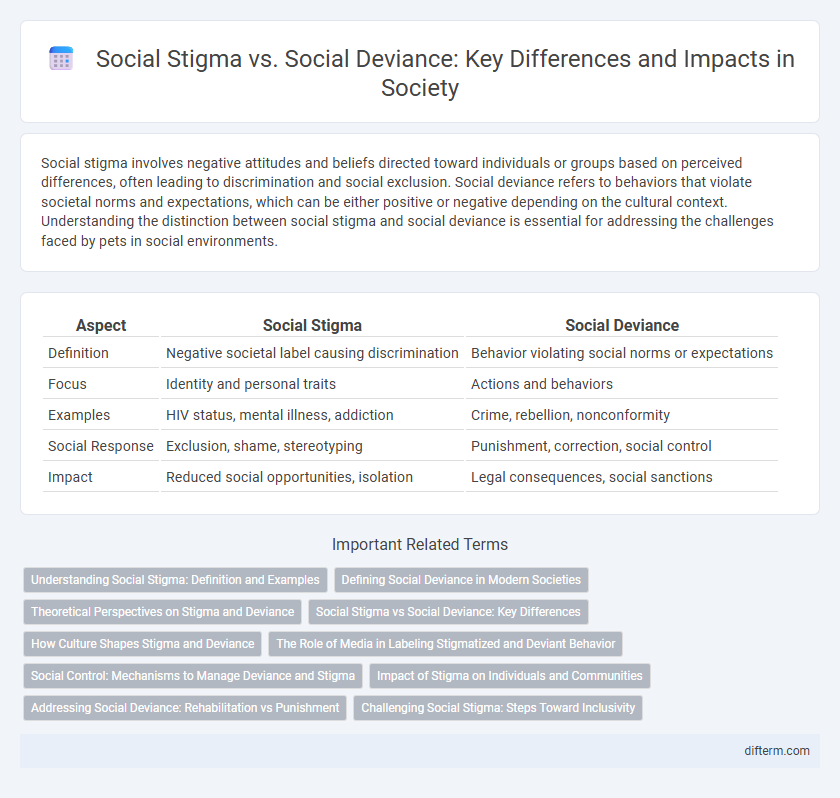Social stigma involves negative attitudes and beliefs directed toward individuals or groups based on perceived differences, often leading to discrimination and social exclusion. Social deviance refers to behaviors that violate societal norms and expectations, which can be either positive or negative depending on the cultural context. Understanding the distinction between social stigma and social deviance is essential for addressing the challenges faced by pets in social environments.
Table of Comparison
| Aspect | Social Stigma | Social Deviance |
|---|---|---|
| Definition | Negative societal label causing discrimination | Behavior violating social norms or expectations |
| Focus | Identity and personal traits | Actions and behaviors |
| Examples | HIV status, mental illness, addiction | Crime, rebellion, nonconformity |
| Social Response | Exclusion, shame, stereotyping | Punishment, correction, social control |
| Impact | Reduced social opportunities, isolation | Legal consequences, social sanctions |
Understanding Social Stigma: Definition and Examples
Social stigma refers to the negative attitudes and beliefs that society holds against individuals or groups based on characteristics such as race, illness, or behavior, leading to discrimination and social exclusion. Examples include the stigma faced by people living with HIV/AIDS, mental health conditions, or those belonging to marginalized communities. Understanding social stigma is crucial for addressing its impact on social interaction, self-esteem, and access to resources.
Defining Social Deviance in Modern Societies
Social deviance in modern societies refers to behaviors or actions that violate established social norms and cultural expectations, challenging accepted standards. It encompasses a wide range of activities, from minor infractions such as dress codes to serious offenses like criminal acts, reflecting society's dynamic boundaries. Understanding social deviance involves examining how power structures and cultural diversity influence definitions and responses to norm violations.
Theoretical Perspectives on Stigma and Deviance
Theoretical perspectives on social stigma emphasize Erving Goffman's concept of stigma as a discrediting attribute that reduces an individual's social value, while social deviance is often analyzed through Robert K. Merton's Strain Theory, which explains deviance as a response to the gap between societal goals and means. Labeling theory highlights how societal reaction to deviant behavior reinforces stigma, creating a cycle of exclusion and identity transformation. Conflict theory argues that power dynamics shape definitions of deviance and stigma, reflecting and perpetuating social inequalities.
Social Stigma vs Social Deviance: Key Differences
Social stigma involves negative societal attitudes and stereotypes directed toward individuals based on characteristics such as race, illness, or behavior, leading to social disapproval and discrimination. Social deviance refers to actions or behaviors that violate established social norms or laws, often triggering social stigma as a response. The key difference lies in social stigma being an imposed social perception, while social deviance pertains to the actual conduct deviating from societal expectations.
How Culture Shapes Stigma and Deviance
Culture profoundly influences social stigma and deviance by defining norms and values that determine acceptable behavior within a community. Collective cultural beliefs label certain actions or identities as deviant, resulting in stigma that enforces conformity and social control. Variations in cultural contexts lead to diverse definitions of deviance and the intensity of associated social stigma.
The Role of Media in Labeling Stigmatized and Deviant Behavior
Media heavily influences the public perception of social stigma and social deviance by framing behaviors through selective reporting and sensationalism, which often perpetuates stereotypes. News outlets and entertainment media label individuals or groups as deviant or stigmatized, reinforcing social boundaries and shaping societal reactions. The repeated portrayal of marginalized behaviors in negative contexts solidifies societal norms and affects policy-making and social inclusion.
Social Control: Mechanisms to Manage Deviance and Stigma
Social control mechanisms such as formal sanctions and informal social norms regulate behavior to manage social deviance and stigma, maintaining societal order. Stigma often leads to social exclusion and labeling, which differs from deviance, where acts directly violate established norms and laws. Institutions like the legal system, education, and family enforce conformity by imposing penalties or promoting rehabilitation to reduce deviant behavior and mitigate stigma's social impact.
Impact of Stigma on Individuals and Communities
Social stigma often leads to marginalization, reduced self-esteem, and limited opportunities for individuals, profoundly affecting their mental health and social integration. Communities experiencing widespread stigma can face fragmentation, decreased social cohesion, and barriers to collective progress. The negative impact of stigma exacerbates social inequalities and hinders efforts to address deviance constructively.
Addressing Social Deviance: Rehabilitation vs Punishment
Addressing social deviance requires a balanced approach between rehabilitation and punishment to effectively reduce repeat offenses and promote societal reintegration. Rehabilitation programs focus on transforming deviant behavior through education, therapy, and skill development, reducing stigma and supporting positive social identity. In contrast, punitive measures emphasize deterrence and societal condemnation, which may reinforce social stigma and hinder long-term behavioral change.
Challenging Social Stigma: Steps Toward Inclusivity
Challenging social stigma involves actively promoting awareness and education to dismantle harmful stereotypes and biases associated with marginalized groups. Encouraging inclusive dialogues fosters empathy and understanding, which are crucial in reducing discrimination and social exclusion. Implementing supportive policies and community programs enhances social integration and empowers individuals facing stigma to reclaim their identities and contribute meaningfully to society.
Social Stigma vs Social Deviance Infographic

 difterm.com
difterm.com